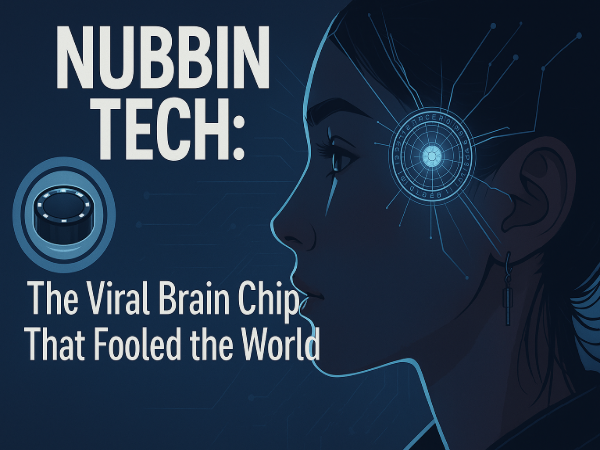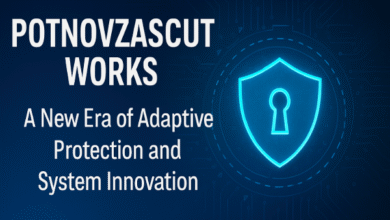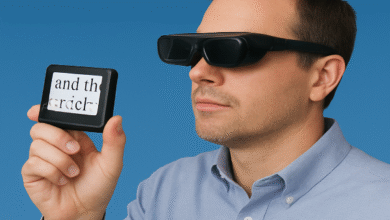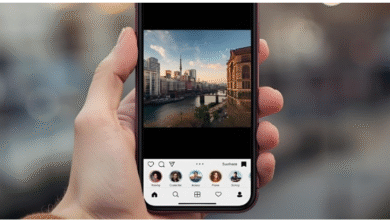Nubbin Tech: The Viral Brain Chip That Fooled the World
How a Fictional Neural Implant Sparked Curiosity, Debate, and Global Attention

Nubbin Tech became a viral sensation across social media when it was introduced as a futuristic coin-sized neural implant promising to relive memories, regulate emotions, and optimize consciousness. Marketed with sleek unboxing videos, mysterious promotional blurbs, and convincing influencer demonstrations, Nubbin Tech seemed real enough to capture the imagination of millions. However, the truth soon emerged: it was not a groundbreaking invention but rather a brilliantly executed marketing campaign tied to Black Mirror Season 7. The hoax left many questioning the blurred lines between fiction and reality, while also sparking genuine conversations about the future of neurotechnology.
Introduction
In a world where technology evolves faster than our ability to adapt, few concepts strike a chord as strongly as the idea of controlling consciousness. When Nubbin Tech appeared on social media feeds, it seemed to herald a new dawn of human potential. Small, sleek, and futuristic, this so-called implant promised to transform how people experienced memory, emotion, and reality itself.
Unboxing videos showed influencers holding small black discs, pressing them against their temples, and staring ahead with pupils glazed over. Promotional descriptions promised features like “dream-safe encryption,” “real-time mood modulation,” and a “Gen-9 neural processor.” For a moment, the illusion was powerful enough to convince millions that a revolutionary brain chip had quietly entered the market.
But as the dust settled, it became clear: Nubbin Tech wasn’t real. Instead, it was a carefully crafted marketing hoax for the dystopian series Black Mirror. Yet the conversation it sparked was very real. People began debating the ethics of neural implants, the potential of real-world brain-computer interfaces, and how far technology could actually go in reshaping human experience.
This article explores the phenomenon of Nubbin Tech in detail: its viral rise, the marketing genius behind it, the cultural conversations it inspired, and what it reveals about our readiness for the next stage of neurotechnology.
The Rise of Nubbin Tech on Social Media
The Unboxing Hype
The campaign began subtly. Influencers received mysterious black boxes containing small devices that resembled futuristic wearables. In short clips, they pressed the coin-sized “Nubbin” against their temples, and soon after, their eyes appeared to glaze over as though they were transported into another reality.
The production quality of these videos was flawless. They mimicked genuine product launch trends seen in the tech industry, with the same aesthetic used by major companies unveiling smartphones or VR headsets. The deliberate use of influencers gave the impression that Nubbin Tech was already out in the wild, being tested by early adopters.
The Promise of Consciousness Optimization
The promotional blurbs made bold promises:
Reliving cherished memories with crystal clarity.
Real-time emotional regulation to reduce stress, anxiety, or anger.
Entering dream states safely with encrypted protection.
Enhanced cognitive clarity and heightened sensory perception.
In a world obsessed with productivity, mindfulness, and self-improvement, these promises struck directly at human desires. The concept of “optimizing consciousness” felt both futuristic and attainable, which fueled the virality of Nubbin Tech across platforms like TikTok, Instagram, and Reddit.
The Reveal: Fiction Masquerading as Reality
Connection to Black Mirror
Nubbin Tech was eventually revealed as a fictional device created for the Netflix series Black Mirror. The implant played a role in several Season 7 episodes, serving as a narrative tool to explore themes of memory, reality, and identity. The fictional company TCKR Systems was presented as the manufacturer, complete with a realistic-looking website, terms and conditions, and even mock press releases.
Why People Believed It
Several factors made the campaign convincing:
Professional Branding – The official website mirrored modern tech branding, complete with sleek visuals and futuristic jargon.
Influencer Endorsement – Social media personalities made it look like a genuine consumer product launch.
Tech Timing – With real companies like Neuralink working on brain implants, the idea of Nubbin Tech did not seem far-fetched.
Cultural Curiosity – People are increasingly fascinated by mind-hacking, consciousness studies, and AI, making them more receptive to such claims.
The result was a marketing masterstroke. For days, social media buzzed with discussions not just about Nubbin Tech but about the broader implications of human-technology integration.
The Psychology Behind Believing Nubbin Tech
Why were people so quick to believe in Nubbin Tech? The answer lies in the psychology of plausibility and desire.
Humans are naturally drawn to technology that promises to eliminate pain and enhance pleasure. Memory recall, emotional regulation, and consciousness optimization all represent powerful human aspirations. When a concept aligns so closely with what people already desire, it becomes easier to suspend disbelief.
Moreover, society has grown accustomed to rapid technological leaps. Smartphones, VR, AI assistants, and even the early stages of brain-computer interfaces have conditioned people to expect science fiction to become reality at any moment. In this climate, Nubbin Tech felt believable, even inevitable.
Nubbin Tech vs. Real Neurotechnology
While Nubbin Tech was fictional, it highlighted real advancements in neuroscience and technology. Several companies and research groups are already developing neural implants, though their goals are far more modest compared to the dramatic claims of Nubbin.
Neuralink and Brain-Computer Interfaces
Elon Musk’s company Neuralink has created a coin-sized implant capable of reading brain signals and translating them into computer commands. The initial goal is to help patients with paralysis control devices directly with their thoughts. Unlike Nubbin Tech, Neuralink does not promise dream encryption or emotion regulation, but its existence made the Nubbin hoax more plausible.
Medical Applications of Implants
Other real-world applications of neural technology include:
Treating epilepsy through deep brain stimulation.
Restoring movement in patients with spinal injuries.
Researching implants for treating depression and other mood disorders.
These technologies are grounded in medical science rather than consumer marketing, but they represent meaningful steps toward the kinds of capabilities Nubbin Tech pretended to offer.
The Cultural Impact of Nubbin Tech
The campaign went beyond marketing; it became a cultural moment. Conversations around Nubbin Tech touched on ethics, privacy, and the future of humanity.
Ethical Concerns Raised
Even though fictional, Nubbin Tech sparked real debates:
Should humans alter their emotions through implants?
Who owns the data generated by brain-computer devices?
Could such implants be hacked, leading to identity theft or emotional manipulation?
Would access to consciousness-optimizing tech widen inequality between rich and poor?
Blurring of Reality and Fiction
The hoax also revealed how blurred the line between reality and fiction has become. In an age of deepfakes, AI-generated content, and viral marketing, it is increasingly difficult to distinguish between what is real and what is staged. Nubbin Tech exploited this ambiguity to perfection.
Lessons Learned from the Nubbin Tech Phenomenon
Marketing Can Shape Reality – The campaign demonstrated the power of narrative to create belief, even without a tangible product.
Consumers Crave Transformation – The excitement around Nubbin Tech revealed deep cultural desires for memory, emotional, and consciousness control.
Skepticism Is Essential – The phenomenon reminded people to fact-check before believing extraordinary claims.
The Future Is Coming – While Nubbin Tech itself was fictional, it foreshadowed real conversations society will need to have about emerging neurotechnology.
Could a Real Nubbin Tech Exist in the Future?
The idea of reliving memories or modulating emotions through technology may sound like science fiction today, but neuroscience is advancing rapidly. While we are far from the polished promises of Nubbin Tech, progress in brain-computer interfaces suggests that pieces of this vision could one day be possible.
Memory recall through neural implants is being studied in animals, while mood-regulating implants are already in early human trials for depression. If breakthroughs continue, a real-world equivalent of Nubbin Tech may emerge in the coming decades, albeit in a far more limited form.
Conclusion
Nubbin Tech was never real, but it captured the imagination of millions. Through a clever blend of influencer marketing, futuristic design, and cultural timing, it blurred the lines between reality and fiction in a way that few campaigns have ever managed.
The phenomenon was more than a viral stunt—it was a mirror reflecting our collective hopes, fears, and desires about technology. It showed how ready society is to embrace tools that could alter consciousness, even if those tools don’t yet exist.
While Nubbin Tech may have been a hoax, the conversations it sparked are profoundly real. The world is on the brink of unprecedented changes in how humans interact with technology, and the questions raised by Nubbin will remain relevant as we navigate that future.



